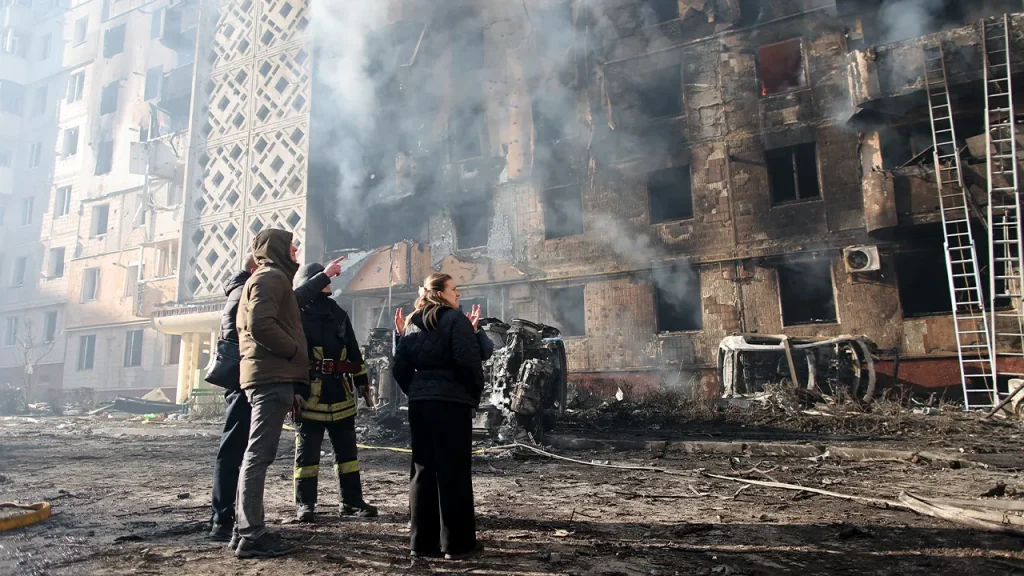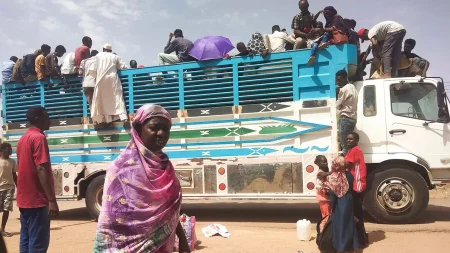Tragedy in Western Ukraine: Russia’s Devastating Overnight Attack
In a devastating escalation of Russia’s campaign against Ukraine, the western city of Ternopil became the site of immense tragedy Tuesday night as Russian forces unleashed a massive aerial assault that claimed at least 25 lives, including three innocent children. The attack targeted two nine-story residential buildings, leaving dozens of families homeless and traumatized. Emergency crews worked tirelessly through the night, digging through rubble in desperate search of survivors while battling fires that engulfed portions of the structures. The images emerging from the scene tell a heartbreaking story: shattered windows, blackened building exteriors, and thick smoke billowing skyward as first responders raced against time. For the residents of Ternopil, a city previously considered relatively safe compared to Ukraine’s eastern regions, this attack shatters any remaining sense of security and demonstrates Russia’s willingness to target civilian populations far from the front lines.
Ukrainian President Volodymyr Zelenskyy revealed the staggering scale of the overnight assault, stating that Russia had launched more than 470 drones and 48 missiles across the country. Beyond the devastating casualties in Ternopil, nine other Ukrainian regions suffered strikes targeting both critical infrastructure and civilian areas. Energy facilities in Lviv came under attack, threatening power and heating as Ukraine faces the approaching winter months. Meanwhile, Kharkiv, Ukraine’s second-largest city, saw renewed targeting of civilian infrastructure, continuing a pattern of attacks on population centers. The coordinated nature of these widespread strikes suggests a deliberate Russian strategy to overwhelm Ukrainian air defenses and maximize damage to both military and civilian targets simultaneously. For Ukrainian citizens across the country, the assault represents yet another night of terror in a war that has stretched on for over two years with no end in sight.
The Ternopil tragedy highlights the brutal reality facing Ukrainian civilians who continue to bear the heaviest burden in this conflict. The Ministry of Internal Affairs reported 73 injuries in addition to the fatalities, with many victims requiring hospitalization for severe trauma. Local hospitals were quickly overwhelmed with casualties, as medical staff worked desperately to treat the wounded with limited resources. The attack’s timing – striking residential buildings at night when families were at home and most vulnerable – underscores the particularly callous nature of these strikes. Among the dead were children whose lives were cut short by a conflict they had no part in creating. For survivors, the psychological trauma compounds physical injuries, as they face the loss of loved ones, homes, and possessions. Many now join the ranks of Ukraine’s internally displaced, forced to seek shelter elsewhere as winter approaches with uncertain prospects for rebuilding.
President Zelenskyy used the attack to renew his urgent appeals for expanded Western military support, particularly focusing on air defense capabilities. “Every brazen attack against ordinary life proves that the pressure on Russia is still insufficient,” he stated on social media, highlighting the desperate need for additional air defense missiles and systems to protect Ukrainian skies. He also called for expanded capabilities for Ukraine’s combat aviation and increased drone production to counter Russian aerial threats. These pleas come at a critical moment as questions surround the future of Western military aid, particularly from the United States following recent political developments. The Ukrainian leader emphasized that Russia must face accountability for these attacks and stressed the importance of maintaining international focus on strengthening Ukraine’s defensive capabilities. For Ukrainians enduring these relentless assaults, the question remains whether sufficient aid will arrive in time to prevent future tragedies like the one in Ternopil.
The implications of the attack extend beyond Ukraine’s borders, raising alarm among neighboring NATO countries. Poland’s Operational Command reported scrambling fighter jets and raising air defense readiness in response to the Russian missile and drone barrage. These preventive measures, aimed at protecting Polish airspace near the Ukrainian border, highlight growing concerns about potential spillover effects as Russia intensifies its aerial campaign. Previous incidents of Russian munitions landing in Polish territory have created diplomatic tensions and raised questions about NATO’s response protocols. The proximity of these attacks to NATO borders creates a dangerous potential for miscalculation or unintended escalation between Russia and the alliance. For European nations bordering Ukraine, each massive Russian strike brings renewed fears about regional stability and security, particularly as the war shows no signs of resolution through diplomatic channels.
As rescue operations continue in Ternopil, the attack serves as a grim reminder of the war’s evolving nature and its devastating human cost. What began as a conventional military invasion has transformed into a war of attrition where civilian suffering has become a tactical element. Russia’s willingness to target residential buildings far from the front lines signals its strategy of breaking Ukrainian morale through terror and destruction of critical infrastructure. For Ukrainian citizens, each air raid siren now brings the knowledge that nowhere is truly safe, as Russian missiles and drones can reach any part of the country. Yet amid this horror, Ukrainian resilience remains unbroken. Communities continue to rally around victims, volunteers assist emergency services, and the national determination to resist Russian aggression persists despite the immense sacrifices. As winter approaches and attacks on energy infrastructure intensify, Ukrainians face perhaps their most challenging season of the war, with the tragedy in Ternopil standing as a somber testament to the conflict’s brutality and the urgent need for a path to peace.















